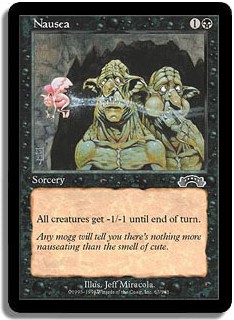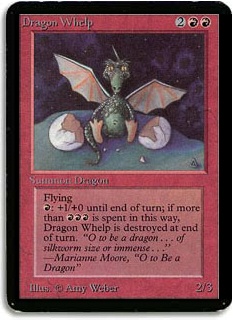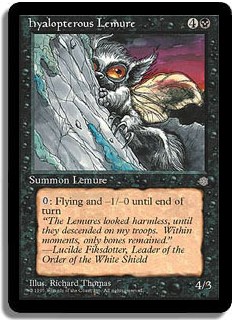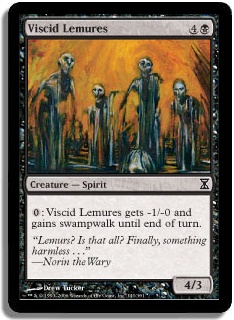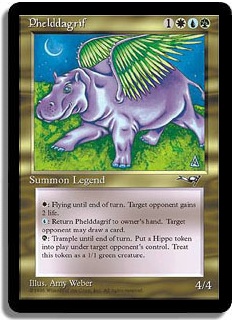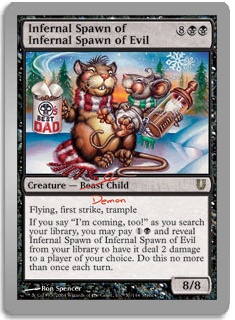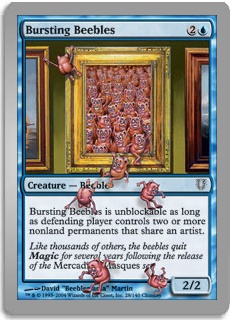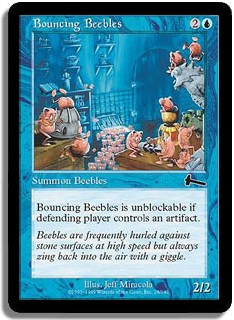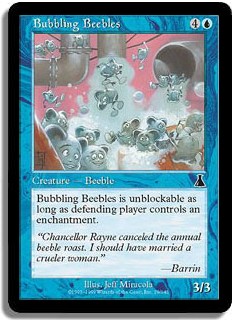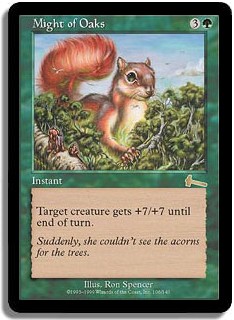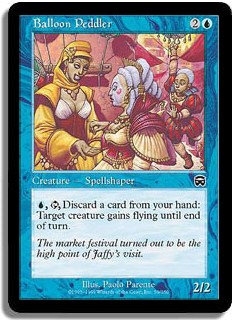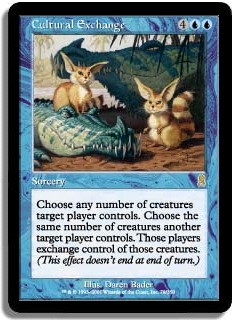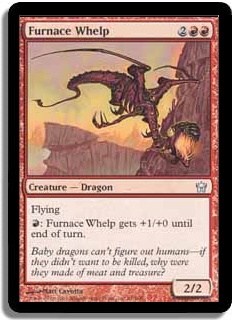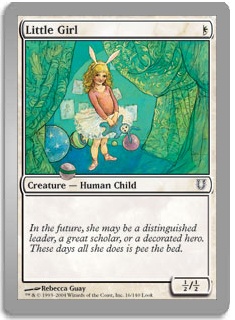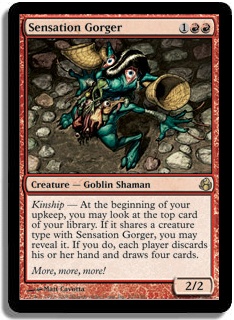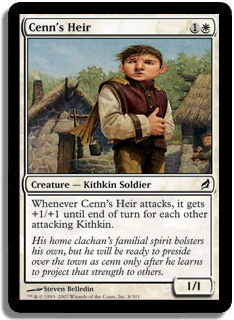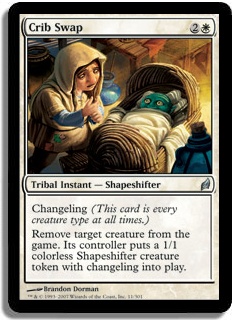This article is, in fact, two articles in one. In the first, John Dale Beety presents the cutest creatures in Magic of all time—from Beebles
to “Lemures.” In the second, he discusses an alternative history of Commander (with contest!).
The Cutest Creatures Of Magic
“Any mogg can tell you there’s nothing more nauseating than the smell of cute.” —Nausea, Exodus
Indeed there isn’t, and the last thing I want to do is make you sick, so I have a little test for you. Before reading the rest of this article,
please watch the following three videos in order. If you are unable to enjoy them (or at least tolerate them), I can make two conclusions about you:
first, that you are unlikely to appreciate this article, and second, that you have no soul.
Puppy Play
(from the Puppy Bowl)
Â
…
Â
…still with me? I’m sorry about the last video. I had to make sure that only the most persevering souls survived the gauntlet.
All right, let’s get with the cute.
Adorable in Alpha: Dragon Whelp
Normally I’m a
huge fan of real-world flavor text, but the effect of the Marianne Moore poem is just jarring. The just-hatched Alpha Dragon Whelp, as illustrated by Amy Weber, is a thoroughly
befuddled little creature just out of the shell. It almost makes you want to take the little reptile and burp it over your shoulder. Just remember to
put on your firefighter’s gear first! Steven Belledin’s modern interpretation of Dragon Whelp is adorable in its own way as
well…evil-adorable, but adorable nonetheless.
Hyalopterous Lemure
As the Magic Arcana describes, Richard Thomas got the
“hyalopterous” part right, at least on the wings; they’re pretty transparent and glass-like. The “lemure” part, though?
Not so much. He served up a lemur instead, resulting in the cuddliest, flesh-gnawing furry creature ever devised for Magic.
Like several other early art bloopers, this one received a name-check in Time Spiral with Viscid Lemures.
Phelddagrif
Amy Weber strikes again. Just remember, folks: if you’re seeing flying hippopotami, you aren’t necessarily on drugs. You could just be
playing Magic. I’m still holding out for the “Pink Elephants” Commander
deck, myself.
Portal to Cuteness: Bear Cub
Bear Cub: it’s like Runeclaw Bear, only much, much better. Why? Well, let’s face it. Nobody likes Runeclaw Bear. It sniffs and snuffles
around, looking at the long faces of the Magic players who were promised that Magic 2010 would be a set with “all new cards,” only to find
out that many of them were merely renamed cards such as Runeclaw
Bear and Divination. There may not have been too many people torn up over the renaming of Counsel of the Soratami, but Wizards messed with Grizzly
Bears, which didn’t go over well with a lot of flavor geeks. (My approximate reaction.)
Bear Cub might’ve been a functional reprint of Grizzly Bears, but at least there weren’t grand promises thrown around about half the set
being all new cards. There’s also the cuteness factor. I’ll freely admit that I let out an “Aww!” the first time I saw the
cuddly Bear Cub sitting and looking at the bee. I didn’t even notice Mama Bear in the background until I read the flavor text, but she’s
always watching.
The big shocker on Bear Cub is the artist. Up until then, Ron Spencer was known for cards such as Terror and Ashen Ghoul, and he followed it up with
creepy delights such as Bone Shredder and Cabal Therapy, so seeing him swing over to the cute side was a bit of a surprise.
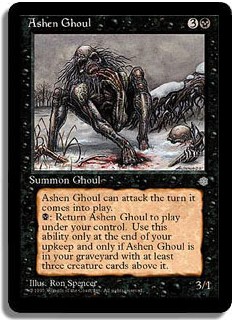
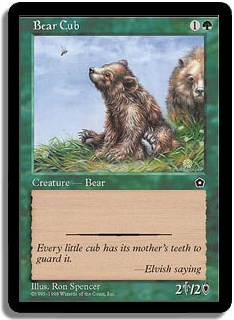
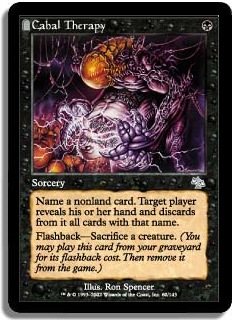
Only one of these illustrations made it into “Ron Spencer’s Big Alphabet Book.” You get two
guesses.
Of course, Bear Cub is only the second-cutest card Ron Spencer has illustrated. In first place…
Cuteness Unglued: Infernal Spawn of Evil
Sure, it’s supposed to be a joke, but the pound-for-pound potency of cuteness on Infernal Spawn of Evil makes it the cutest Magic card of all
time.
(Kanye West check. Safe!)
Infernal Spawn of Evil is also special to me for a recent memory it made. While my mother doesn’t play Magic, she’s supported me ever since
I started playing, and she enjoys looking at beautiful, cute, and otherwise not-especially-edgy artwork for the game. For Mother’s Day this year,
I sent two cards. One was the usual greeting card, blank inside so my words didn’t have to live up to a punch line. Inside the greeting card was
a Magic card: Infernal Spawn of Evil.
It’s what she wanted for Mother’s Day, so I got it for her. That’s right; StarCityGames.com is your new home for Mother’s Day
gifts. They should totally use that tagline next year.
At any rate, when she received it in the mail, she called me up and said (roughly paraphrasing), “I got my Infernal Spawn of Evil! He’s so
cute, the little mousey with his scarf and his cocoa!” My mom taught primary school and kept shelves full of illustrated books, so saying
she’s a connoisseur of cuteness is a bit of an understatement. The Infernal Spawn of Evil has her seal of approval, and when I head back to my
home state for the StarCityGames.com Invitational tournament in Indianapolis, she has an Infernal Spawn of Infernal Spawn of Evil coming to her.
Considering the many nefarious plans she has to spoil me rotten over the Invitational weekend, it’s the least I can do.
Lawrence of Arabia, British Beeblemania?
Beebles are like the Ewoks of Magic’s Urza block; if they weren’t designed with some kind of merchandising campaign in mind, they should’ve been! They’re small, pink, fuzzy,
adorable, and according to the flavor text of Bubbling Beebles, very tasty. (Note to Barrin: it probably would’ve been worth sleeping on the
couch to have the beeble roast anyway. It’s not like Rayne was going to stay mad forever!)
Bouncing Beebles also brings the cuteness, not to mention being fun as all get-out to say, and if one ignores the loudmouth prankster in the foreground
of Donate, that card works too.
David “Beeblemania” Martin’s take on the species, Unhinged’s Bursting Beebles, shows a bit too much well-defined beeble tuckus
for my taste, but it still rates acceptably on the cute-meter. If beebles aren’t to your taste, there’s always the super-cute super-sized
she-squirrel on the original Might of Oaks.
Balloon Peddler
Parente (aka “The Artist Formerly Known as Paolo Parente”) is miscast, and badly, whenever Wizards asks him to illustrate anything but a
warrior-type smashing something. Those masked (masqued?) women are just hideous, especially the eponymous Peddler. That said, poor little Jaffy in the
background is just funny, and he has the cutest “oh crud” face going in the entirety of Masques block.
That may extend to the entirety of Magic, simply because children are shown so infrequently in Magic illustrations; the company wants to avoid the
notion of sending children to fight and die for what I hope are obvious reasons. The major archetypes for children in Magic art are either bystanders
like Jaffy, students such as Disruptive Student, or joke cards (more on this later).
On a Shattered Continent, Small Pockets of Cuteness Remain…
You can have the alligators. I’ll take the long-eared, bushy-tailed creatures. What are they supposed to be? I have no idea, but I’d pet
them anyway.
Furnace Whelp
It’s not about the art; like Mirrodin and Darksteel (and Scars of Mirrodin, Mirrodin Besieged, and especially New Phyrexia), Fifth Dawn
doesn’t exactly truck in cuteness. This one’s all about the flavor text. Can you imagine those lines paired with the original Dragon Whelp
art? It would’ve been pitch-perfect.
Little Girl and the Meddling Kids
I just named the next great Magic: The Gathering—themed rock band.
Most of Rebecca Guay’s art, while classically serene and watercolor-y and beautiful, rarely kicks into cute. (It’s especially not cute when
she tries too hard for cute, as on Silkwing Scout.) On the other hand, Rebecca Guay painting a little girl with blond ringlets, bunny ears, and a tutu?
Cuteness genius. Then there are the Meddling Kids, and I’m still looking for the picture of the Magic player who dressed up as Meddling Mage and
got the kids to dress as Meddling Kids. It has to be out there, right?
Lorwyn Block: Cuteness Wasteland
On first thought, the fairy-tale world of Lorwyn seems like it should’ve been a rich source of cute Magic cards. The aesthetic ran more
“twee” than cute, though. Fortunately, there are a handful of exceptions. Matt Cavotta, always a deft hand with humorous illustrations,
gives Sensation Gorger just the right mix of humor and fur; all hail the skunk-tail! The Kithkin as a tribe were disappointing, but Cenn’s Heir
is at least decent as an adorable kithling, even if he’s more gangling teenager than cute little kithling. The only “baby” kithling
in the block is Crib Swap, but what strikes some people as humorous-cute will affect others in a much less positive way; your mileage may vary.
Plush Perilous Myr
The most recent blocks haven’t lent themselves to cute, but I couldn’t finish this without giving a mention to the plush Perilous Myr
created by Tally Heilke. You know you’ve arrived when you get a Magic Arcana devoted to your work! Monty Ashley called it
“The Cutest Myr,” and I have to agree. I keep checking the store and hoping Tally makes another, because while the blog may be titled
“I Could Make That,” I’m not nearly arts-and-crafts enough to make it happen, and
I want one and if you try to take the next one from me I will make like a Baby Boomer parent chasing a Furby or Tickle Me Elmo and knock you down
and steal it from your cart.
Any questions?
Ahem.
So that’s an overview of cuteness and Magic. What are your top picks for the cute cards of Magic? Do you have a favorite I missed? Let me know in
the forums, and as always, thanks for reading.
— JDB
@jdbeety on Twitter
Â
Elder Language Highlander
The last of the grand-format Prereleases has taken place, and their passing has put me in a bit of a nostalgic mood. My first Prerelease was for
Onslaught, and I’d been waiting with eager anticipation for my Silent Specter promo card. The past two years had seen Prerelease promos printed
in a variety of non-Magic languages: in order, Latin, Classical Greek, Sanskrit, Arabic, Russian, and Hebrew. A friend had picked up a spare Hebrew
promo from the Judgment Prerelease and given me the Glory, for which I was grateful, but I was ready to pick up a Prerelease promo for myself. What
would the language be? Thai, perhaps? Sumerian cuneiform? Maybe some Cherokee?
I paid my money and got my promo.
English?
English?!
I can’t link to the Pulp Fiction scene in which Jules asks whether
a certain character speaks English—this is a family website, after all—but a tiny, tiny bit of that rage was bubbling up in my
not-quite-old-enough-to-vote soul as I walked away.
Now that I’m older and more capable of understanding others’ points of view, I agree with the decision to print the Prerelease promos in
English (or more recently, the appropriate local Magic language). For every four-year Latin student like me who could read Kavu Furens (Latin
for Raging Kavu, the Invasion Prerelease promo), many more players were left scratching their heads and asking, “So what does it do?”
I get that, but I have to admit that when I saw the Arcana announcing New Phyrexia and it had Elesh Norn, Grand
Cenobite translated into their Phyrexian artificial language, my word-geek side was going “Phyrexian-language Prerelease promo? Oh please, oh
please…”
Yeah. Dream-crushed. The Prerelease versions of Sheoldred,
Whispering One are available only in stupid normal languages that humans use on a daily basis.
The world of Prereleases is ever-changing, from a Prerelease Pro Tour (Atlanta 1996) Â and the dead-language
promo cards of Invasion block to the (thankfully temporary) end of Prerelease drafts and the (perhaps more permanent) end of the grand regional
Prereleases. I don’t agree with some of the changes, especially the last, but I have to move on. I won’t let myself become a bitter
nostalgic, 25 and old in a young man’s town.
That doesn’t mean I can’t have fun with a few old memories and a wild flight of fancy, though.
At the time the Invasion and Odyssey block Prerelease promos were printed, all six of the promos—Raging Kavu, Questing Phelddagrif, Fungal
Shambler, Stone-Tongue Basilisk, Laquatus’s Champion, and Glory—were the only Magic cards in their respective languages. Laquatus’s
Champion no longer qualifies, since Russian has been an official Magic language since 9th Edition, but the other living languages of Odyssey block
promos (Arabic for Stone-Tongue Basilisk and Hebrew for Glory) have never been official languages of Magic; the potential markets are simply too small.
The “dead languages,” obviously, have even smaller potential markets; Sanskrit (for Fungal Shambler) and Classical Greek (for Questing
Phelddagrif) are non-starters, and as much as partisans of Latin might protest that it isn’t dead (Living Latin! That one ATM at the Vatican!), sorry, but the nice man is coming around with the cart and
shouting “Bring out your dead!” and guess who’s going on it? (Note
for language-sensitive types: when the funny-looking man with the crown comes onscreen, pause the video, and close the tab. There will be a single
instance of naughty language at the end of the clip, and I wouldn’t want to be the one to besmirch your ears.)
That makes five cards that are unique in their use of their respective languages, and five, in Magic terms, is quite the magic number. (Pun intended.
I’m hardly a pun-maestro on the level of Luis Scott-Vargas, but then, who is?)
(Did you notice I’ve used a lot of parenthetical expressions so far?)
For reasons I still cannot fathom, when I realized that there were exactly five language-unique Magic cards, my thoughts went to Elder Dragon
Highlander. (The format hadn’t been named Commander yet. This idea has been brewing a while.) The history and evolution of the Elder Dragon
Highlander format went a certain way—from “Elder Dragon Legend Wars” in The Duelist to
the Alaska Rules where a legendary creature from Legends had to be the general, all the
way to the modern rules where any legendary creature can be a
Commander—but from my perspective, where I arrived at the format while it was well into maturity, I don’t find anything particularly
inviolable about the rule requiring commanders to be legendary.
I’m not clamoring for any earth-shaking rule changes here. I don’t think that players should be able to pick any old creature as a
commander, and I understand that the specific Commander format has its rule, and that’s that. On the other hand, for small kitchen-table
playgroups where the participants know each other and can agree on variations beforehand, relaxing and tweaking (or, alternately, locking down) the
Commander rule can lead to some interesting variations, almost like alternate histories.
What if the Axis powers had won World War II? The question inspired Philip K. Dick’s The Man in the High Castle. What if a twist of fate had created
an ethnic enclave of more than three million people in Alaska? That’s the premise of Michael Chabon’s The Yiddish Policemen’s Union.
Now what if a certain Alaskan had been obsessed with the Invasion and Odyssey Prerelease promos? We’d be playing Elder Language Highlander.
Elder Language Highlander: The Rules
Elder Language Highlander uses the same rules as the Commander format, with the following exception:
Instead of selecting a legendary creature as a Commander, each participant chooses one of the five Prerelease promo cards printed in a unique Magic
language and builds his or her deck around it.
As a reminder, the five options are:
Latin
– R/G – Raging Kavu (Invasion Prerelease promo)
Classical Greek
– G/W/U – Questing Phelddagrif (Planeshift Prerelease promo)
Sanskrit
– G/U/B – Fungal Shambler (Apocalypse Prerelease promo)
Arabic
– mono-G – Stone-Tongue Basilisk (Odyssey Prerelease promo)
Hebrew
– mono-W – Glory (Judgment Prerelease promo)
Some of you are looking at the Oracle text for those cards and thinking, “Balance issues!” Guess what? You’re absolutely right. As
commanders, the Invasion Block cards have far more color flexibility than their Odyssey Block counterparts, and while Glory at least has a
“build-around-me” ability, Stone-Tongue Basilisk has…it’s not even deathtouch. It does have a Lure ability, but only when you have
threshold. All things considered, if it’s Team Hebrew versus Team Sanskrit for all the marbles, the enemy-color flexibility of Team Sanskrit
gives that deck far more ability to handle anything the Glory deck throws at it, at least in theory.
In practice—and I’ve found this to be true with many different games, not just Magic—when there’s a small, closed playgroup for
a competitive game, the playgroup will either fly apart with the rules as they are written or arc toward stability by altering the rules. In the
alternate history of Elder Language Highlander, I imagine the format took the latter route; the Invasion block promo-wielders intentionally toned down
their decks to make them more balanced with the best Odyssey block decks. Perhaps there was a time when the decks were all monocolor save for their
mana bases, with the Raging Kavu deck taking red, Questing Phelddagrif blue, and Fungal Shambler black—a rule that later went away as new cards
were added to the pool.
The Challenge
I’ve toyed around with a few ideas for how Elder Language Highlander decks might look, but I’m no Sean McKeown, Sheldon Menery, or Bennie
Smith in the Commander department. That said, I’m intrigued by the idea of Elder Language Highlander decks and curious how the format might play
out.
That’s where you come in. I want you to send me your best shot at an Elder Language Highlander deck. I can’t promise cake or pie and punch, but there will
be shinies as prizes.
Here are the rules:
1) Construct an Elder Language Highlander deck using the rules above—in other words, a 100-card Commander deck built around one of the five
language-unique promo cards instead of a legendary creature.
2) Write a brief (under 100 words) statement about the play style, goal, and themes of your deck. Flavor counts almost as much as structural integrity,
and please organize your deck…if it’s a total mess, that’ll hurt your chances.
3) You may submit multiple decklists, but only one deck per card. (In other words, one Raging Kavu deck, one Questing Phelddagrif deck, etc.)
4) Send the decklist(s) and explanation(s) in the body of an e-mail to [email protected] with the subject
line “Elder Language Highlander” and no attachments. I don’t particularly care about that e-mail address getting
spam-infested—it’s already pretty bad—but you don’t want your submission getting swept out with the rest of the garbage.
5) Prizes! I’ll pick out my favorite decklist themed around each card. I’ll send the creator of each winning decklist a copy of that
deck’s commander, so if you’ve always wanted a Questing Phelddagrif in Classical Greek, now’s your chance. (Limit of two promo cards
per person—I have to spread the wealth a little.)
6) By entering the contest, you agree to have your name (or a chosen pseudonym) appear in one of my future articles, along with your decklist.
**
I hope you’ve enjoyed this little romp through Prerelease promos, Alaskan themes, and alternate histories. I’m looking forward to seeing
the results of the community’s creativity, and I hope you are too. Until next time!
— JDB
@jdbeety on Twitter
Â

